The Missouri Dead Animal Law requires that an animal carcass be properly disposed of within 24 hours of death. Missouri has five acceptable methods of carcass disposal: rendering, composting, landfilling, incineration and burial.
Class I operations are not to use burial as their normal method of disposing of routine mortalities. Before burying a large number of unexpected mortalities, operations must receive approval from the Missouri Department of Natural Resources (DNR) and then proceed in accordance with Missouri Department of Agriculture requirements.
This publication discusses static, or passive, composting as a means of complying with the dead animal law for swine operations. Done correctly, composting provides a biosecure method of animal carcass disposal. The information presented here can help swine farmers correctly design and consistently operate these facilities
For information on the other carcass disposal methods, refer to MU Extension publication WQ216, Dead Animal Disposal Laws in Missouri.
Composter location
The composter should be located away from areas of sensitive water quality, such as streams, ponds and wells. A location at or near the crest of a hill will eliminate or minimize the amount of surface water approaching the composter from higher areas. If a composter must be located in the lower part of a slope, a diversion terrace should be constructed around the upper side of the composter to keep surface water out.
When locating a composter, consider the farm residence and any nearby neighbor residences that might be affected. Although offensive odors are not generated if the composting process is properly managed, the sight of the dead swine and compost may be objectionable.
Also, consider traffic patterns required in moving dead swine to the composter, moving the required ingredients to the composter, and removing finished compost from the composter. The composter site should be well-drained and provide all-weather capability for access roads and work areas.
Composting ingredients and recipe
Composting dead swine requires the addition of a carbon source to ensure proper carbon-to-nitrogen ratios are present for the composting process. Experience thus far suggests that sawdust is an ideal carbon source due to its small particle size, ease of handling, absorbency, and high carbon content. Using straw as the only carbon source has been less successful, with lower composting temperatures, leaching of fluids from the composting pile, and longer composting times required. When sawdust is used as a carbon source, plan to provide about 100 cubic feet of sawdust per 1,000 pounds of carcass to be composted. For farrow-to-finish operations, sawdust requirements are about one-third to one-half cubic yards per sow in the herd on an annual basis. See Table 1 for a summary of compost criteria.
A precise carbon-to-nitrogen ratio does not seem to be necessary to obtain good composting, and most composting with sawdust as the carbon source has been done without adding supplemental nitrogen. However, if sawdust is used according to the above recommendations, some supplemental nitrogen would have to be added to obtain the ideal carbon-to-nitrogen ratio of 25-to-1. The addition of about 3 pounds of ammonium nitrate (NH4NO3) in the dry, granular form per 100 pounds of swine carcass will provide the nitrogen necessary to achieve a carbon-to-nitrogen ratio of about 25-to-1. The ammonium nitrate should be mixed with the sawdust used to cover the carcass and can be applied by simply hand-scattering as carcasses are covered with sawdust. As noted previously, most composting is accomplished without the use of additional nitrogen, but this practice may help in starting up new composting operations and obtaining the desired composting temperatures.
The type of sawdust used in composting can influence the success of the operation. Although a fine or small particle size sawdust is not necessary, wood chips and shavings do not seem to work well due to their larger particle size. Sawdust or wood refuse material derived from bark or mulching operations may contain rocks, stones and other foreign material as well as excessively large wood particles, and should not be used for composting.
Most sawdust in Missouri is obtained from sawmills, lumbering and logging operations, or cabinet making and furniture making businesses. Such sawdust is generally quite adequate for composting. The moisture content and bulk density of sawdust are important factors in composting. Bulk density is important in estimating the amount of sawdust to use; moisture content, which also affects bulk density, should be in the proper range for composting. Tests on fresh sawdust obtained from seasoned logs or kiln-dried lumber indicate a bulk density of 16 to 20 pounds per cubic foot with a moisture content of 20 to 30 percent. Sawdust stored in a pile tends to gain moisture content. Tests on aged sawdust (more than 5 years old) showed moisture content in the 50 to 70 percent range and bulk density of about 30 pounds per cubic foot. Most of the increase in bulk density is due to the increase in moisture content.
The ideal moisture content in a composting pile is 50 to 60 percent. Swine carcasses have a moisture content near this range, and much sawdust obtained from outside piles may also be near this range. Hence, it may not be necessary to adjust moisture content or add water in the composting recipe. However, if the sawdust is exceptionally dry or the composting pile becomes dry due to the internal heat generated, it may be necessary to add water for optimal composting.
The moisture content of sawdust or a composting mixture can be judged somewhat by its appearance and feel. Sawdust that has a damp appearance and feel is probably near the proper moisture content for composting. If it appears wet, or free water can be squeezed out, it should be allowed to dry to a damp condition before being used. Fresh sawdust taken immediately from sawing kiln-dried lumber or seasoned logs will probably be too dry and water will have to be added. Add water as needed to obtain a damp feel and appearance in the sawdust. Very dry sawdust (20 percent moisture) may require the addition of 1 to 1-1/2 gallons of water per cubic foot of sawdust to obtain the proper moisture content. Water should be mixed with the sawdust by sprinkling or spraying as the sawdust is placed on the carcasses. Avoid the over-addition of water, as excessively wet mixtures do not compost properly and may require removal and mixing with dry sawdust to recover the process. "Green" sawdust from fresh-cut, unseasoned logs may have a moisture content as high as 80 percent. Green sawdust may be too wet for optimal composting, and should be allowed to dry somewhat or should be mixed with drier sawdust or finished compost before using. A waterline and hydrant installed at the composter will facilitate water addition and general cleanup activities.
Temperature is the best indicator that the composting process is proceeding properly. Temperatures in the composting pile should rise to the 130 to 160 degrees F range, indicating active microbial activity and breakdown of the carcasses.
Table 1
Summary of swine composting design and management criteria
- Sawdust requirements
- One-half cubic yard of sawdust per sow in the herd for farrow-to-finish operations (annually) or 100 cubic feet (about 4 cubic yards) of sawdust per 1,000 pound carcass composted.
- Nitrogen addition
- Up to 3 pounds ammonium nitrate per 100 pounds swine carcass, as needed; mix with sawdust.
- Water addition
- If sawdust is dry, add water to obtain a damp feel and appearance, up to 1 to 11/2 gallons per cubic foot of sawdust.
- Composter size
- 20 cubic feet of primary and secondary bin volume per pound of carcass composted daily.
Size bins for floor area of 100 to 200 square feet, and depth of 5 to 6 feet. - Temperature
- 130 to 160 degrees F indicates active composting.
- Time
- Compost three months in primary bins and an additional three months in secondary bins.
Composter design
The composting process requires the proper ingredients to be placed in composting bins in the correct proportions, allowed to compost for a period of time, and then moved to a second bin for a secondary composting phase. A minimum of three months composting time is needed in both the primary and secondary phases. It may be necessary to extend this period of time if many large carcasses are composted, or if ambient temperatures are low enough to slow the composting process.
In most cases, a minimum of three bins will be required, two of which are used for primary composting and the third for secondary composting. In the typical scenario, Bin 1 is filled with three months' death loss, at which time Bin 2 is started. At the end of the second three-month period, Bin 2 is full, and the last carcasses placed in Bin 1 have composted for three months. The contents of Bin 1 are then ready to move to Bin 3 for the secondary composting phase.
After three months of secondary composting, the material in Bin 3 can be moved out and applied to land, and the secondary bin will be available to receive the contents of Bin 2. Larger operations will require more than the minimum three bins; having extra bins available for storage of fresh sawdust and finished compost is beneficial.
Total bin area and volume requirements depend on the size of operation and death loss incurred. Actual past death loss data should be used in sizing composters for existing operations. For planning purposes and sizing composters for new operations, see the average death loss data in Table 2. A minimum of 20 cubic feet of volume is needed in both primary and secondary bins per pound of carcass composted daily. Bins are typically filled to a depth of 5 to 6 feet for composting. Although bin configuration is not critical, bins are usually laid out as three-sided enclosures. The open side should be at least two feet wider than the loader bucket so that the bin contents will be easily accessible with a front end or skid-steer loader. Square bins allow for less heat loss through walls, although length-to-width ratios of up to 2-to-1 are acceptable. Primary and secondary bins should be located near or beside each other, perhaps with a common wall, to facilitate moving compost from bin to bin. Bins with 100 to 200 square feet of surface area work well. Excessively large bins should be avoided. See Table 1 for a summary of composter design criteria.
Table 2
Average annual death loss for swine in confinement
| Animals | Weight range | Average weight | Annual death loss | Annual death loss per animal space |
|---|---|---|---|---|
| Sow herd1 | 350–400 pounds | 375 pounds | 6–8 percent | 21–32 pounds |
| Nursery2 |
13–50 pounds |
32 pounds | 22–26 percent | 3–13 pounds |
| Finishing | 50–250 pounds | 150 pounds | 10–12 percent |
5–30 pounds |
1. Includes all mature animals, farrowing, gestating and boars.
2. Includes losses in farrowing house prior to weaning.
Note: Death losses can vary significantly from the values shown above depending upon genetics, management, environmental conditions and many other factors.
Composter construction
Before you build a composter, you must decide whether to put a roof over it (Figure 1). Current Missouri regulations do not require a roof or concrete floor in a swine composter, provided that sawdust is used as the carbon source in the composter. Properly mounded and landscaped sawdust effectively sheds water; fluids do not leach from the bottom of properly managed swine composters. The use of other carbon sources may require a roof to exclude rainwater and leaching from the pile. Less absorbent carbon sources, such as straw, may result in leaching and less effective composting even though the composter is roofed.
The primary advantage of an unroofed composter is reduced cost (Figure 2). Advantages of roofed composters include fewer weather effects on the composting process, worker protection during inclement weather, and more attractive buildings that match the others in the production unit.
Field experience suggests that composting bins can be constructed using large round bales (5 to 6 feet in diameter) of low-quality hay (Figure 3). Bales are placed end-to-end to form walls for three-sided enclosures or bins. A layout three bales deep and two bales wide as shown in Figure 4 has worked well for swine composters.
Another alternative for the unroofed composter is to use concrete for the bin floor and walls. Although more costly, the concrete is a more durable construction material and is less subject to weathering and mechanical damage during cleaning operations. Also, a concrete composter takes up less room than a similar composter made with large round bales.
Figures 5 and 6 are schematic drawings of one possible configuration for a roofed composter. This design uses concrete for the bin walls and floor and pole construction for the end walls and roof. The roof overhang and concrete apron in front of the composter minimize rain blowing into the bins and provide a solid work area in front of the composting bins. Many other layouts and materials and could be used in constructing a composter.
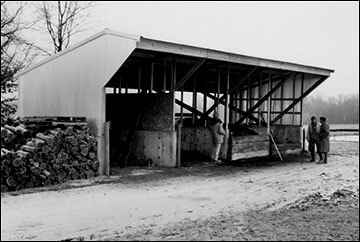 Figure 1
Figure 1
This roofed composter has concrete bin walls with a roof overhang to protect the work area.
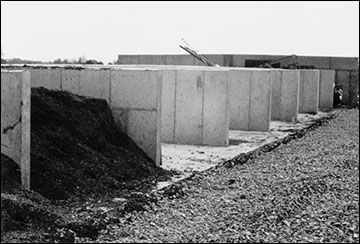 Figure 2
Figure 2
This unroofed composter with concrete bin walls serves a large finishing operation.
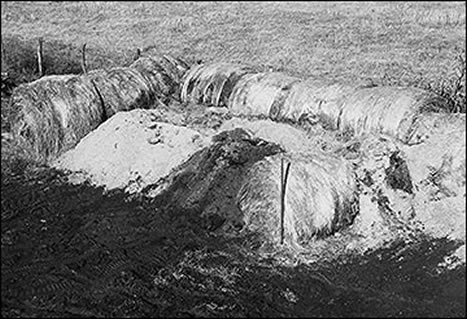 Figure 3
Figure 3
This composter, constructed with large, round bales, serves a 120-sow farrow-to-finish operation.
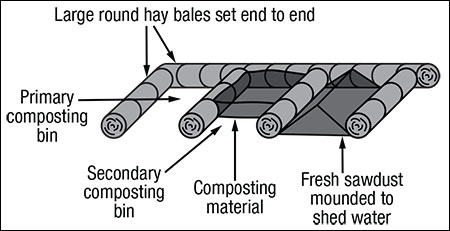 Figure 4
Figure 4
Sample composter layout using hay bales.
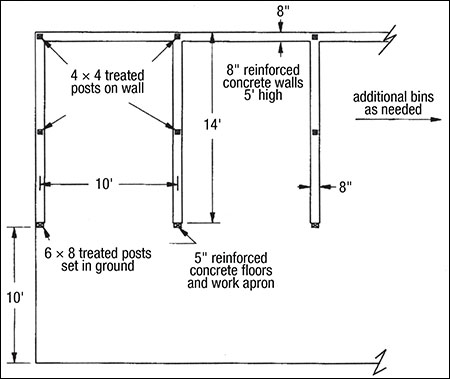 Figure 5
Figure 5
Schematic top view of a roofed composter with concrete bin walls.
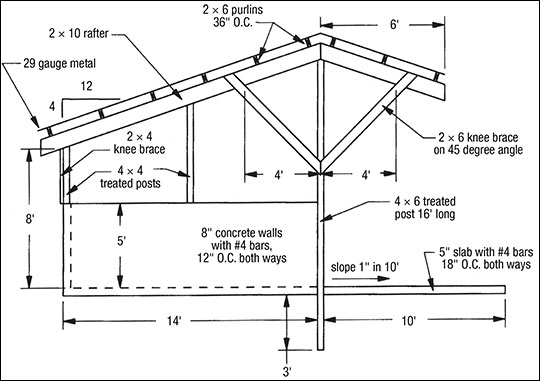 Figure 6
Figure 6
Schematic side view of a roofed composter with concrete bin walls.
Equipment requirements
Although composting is a simple process, certain equipment is necessary for good management of an operation.
Some type of front-end or skid-steer loader is the most necessary piece of equipment in a composting operation (Figure 7). The loader is needed to move carcasses from the production buildings to the composter. Although small carcasses can be deposited and covered in the composter by hand, larger carcasses cannot be adequately managed by hand. The loader provides a means to properly place larger carcasses in the compost pile and adequately cover the carcasses with sawdust of finished compost. The loader is also needed to move compost from primary to secondary bins and can be useful in receiving, storing and piling fresh sawdust from the sawmill. Finally, the loader is necessary for loading out finished compost for field spreading.
A probe-type thermometer will aid in monitoring the compost to determine if it is composting properly. Dial-type thermometers with a minimum 36-inch stainless steel stem allow measurement of temperatures in the interior of the composting pile. Temperatures should rise to the 130 to 160 degree F range for good composting (Figure 8).
A manure spreader should be available for field spreading finished compost. A conventional beater-type spreader for handling solid manure is also adequate for land-applying finished compost.
A logbook is a useful record-keeping tool in a composting operation. Dates and weights of carcasses placed in the composter provide a record of death losses and a basis for improving death loss statistics. Recording of temperature readings, amounts of fresh sawdust inventoried and used, and dates when compost is transferred from primary to secondary bins can aid in managing the composting operation. Finally, dates and amounts of finished compost removed for land spreading also provide data for future management and planning.
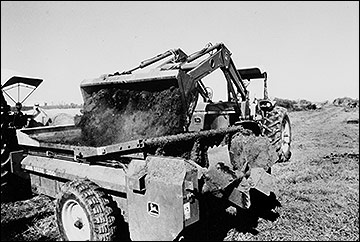 Figure 7
Figure 7
A front-end loader and beater-type spreader work well for loading and field-spreading compost.
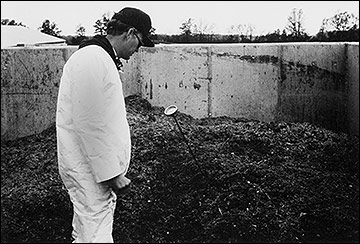 Figure 8
Figure 8
Temperature is the best indicator of the conditions of the composting material.
Composter operation and management
Although composters are simple and relatively easy to operate and manage, certain steps and procedures are necessary to ensure that the process proceeds properly. The steps that should provide acceptable finished compost in a swine operation are described below.
Steps in operating and managing a swine composter
- Start a primary composting bin by placing enough sawdust in the bin so that there is at least one foot under and around the first carcasses placed in the bin. Carcasses placed directly on dirt or concrete floors or against bin walls will not compost properly.
- Place carcasses in the primary bin as necessary. Ensure that each carcass is covered on all sides with a minimum of 1 foot of sawdust. Small pigs may be grouped or placed with less sawdust between carcasses, but always maintain a 1-foot covering between carcasses and the pile surface to minimize odors and rodent problems. Never leave hoofs, legs, ears or snouts sticking out of the sawdust pile. Most problems in swine composting arise when insufficient sawdust is used in covering carcasses. Use a pointed rod or dowel to measure the thickness of the sawdust cover. Large carcasses may need to be re-covered after a day or two as the sawdust settles around the carcass. Keep the surface of the pile shaped so that it will shed rainwater out the front of the bin if the composter is not roofed. Do not allow pockets to form in the bin corners or elsewhere that will pool water.
Carcasses placed in warm sawdust begin composting more quickly. Overfill sawdust over the previous carcasses, and the sawdust will heat up. Then use the loader bucket to "wallow-out" a cavity in the warmed sawdust, and place the fresh carcass in this cavity. If finished compost is available, use it to cover the carcass to provide additional heat and bacteria to start the composting process. Then add fresh sawdust to provide the final cover thickness needed so a new cavity can be provided for the next carcass (Figure 9). - Monitor temperature of the composting pile with a long-stem dial-type thermometer. When composting is proceeding properly, temperatures will reach 130 to 160 degrees F. If a thermometer is not available, you can get a rough indication of temperature by inserting a steel rod in the compost pile and feeling how hot it is when you pull it out. Primary bins started during cold weather may not begin composting immediately; however, if carcasses are buried with the proper amounts of sawdust, composting should begin on its own as temperatures warm in the spring. Active, as opposed to newly started, compost piles are usually generating enough heat to continue composting through cold weather regardless of ambient temperature. If sawdust is used as recommended, it usually provides enough insulation to minimize the effects of ambient temperature.
- After the last carcasses placed in the primary bin have composted three months or longer, move the contents to a secondary bin. Doing this provides mixing and re-aeration of the material so that the compost will "finish off" properly.
- After the pile has composted another three months in the secondary bin, it should appear as a dark, nearly black granular material resembling humus (Figure 10) and have very little odor. Some resistant parts such as teeth may still be identifiable but should be soft and easily crumbled.
- Use the finished compost as noted in Step 2 for "starter" material on the new carcasses being composted in the primary bin. It will provide heat and bacteria to help start the composting process. When starting a composting operation, use fresh sawdust in the amounts noted until sufficient finished compost becomes available. When finished compost is available, it can be used to fulfill up to 50 percent of the sawdust requirement for composting. Haul and spread finished compost as needed using a conventional manure spreader. Apply finished compost at agronomic rates for the crop being grown. Obtain a laboratory analysis of the compost for nitrogen (N), phosphate (P2O5) and potash (K2O) for precise fertilizer content. Table 3 gives average values of fertilizer nutrients from several samples of finished swine compost.
- Keep fresh sawdust as dry as possible because dry sawdust works better in the composting process. Fresh sawdust in a pile will shed water reasonably well if the pile is mounded, with no pockets or depressions.
- Keep the area around the composter mowed and free of tall weeds and brush. Watch for leaching. Using more sawdust in the bottom of the bins can help eliminate leaching.



Figure 9
Steps to proper placement of carcasses in the composter, from left: Dig out a cavity with the loader. Place the carcass in the cavity. Cover the carcass with finished compost to add heat and bacteria.
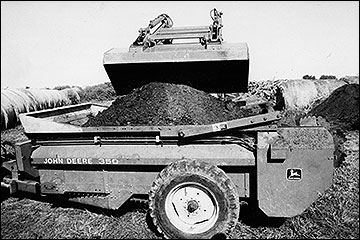 Figure 10
Figure 10
Properly finished compost is a dark granular material resembling humus.
Table 3
Nutrient contents of finished compost and fresh sawdust.
| Fertilizer nutrients (pounds per ton wet basis) | |||||
|---|---|---|---|---|---|
| Material | Dry matter | Total nitrogen | Ammonia nitrogen | P2O5 | K2O |
| Finished compost | 1,000 | 20 | 4 | 2 | 6 |
| Fresh sawdust | 800 | 1 | 0 | 0.2 | 0.4 |
Frequently asked questions
Certain questions about composting frequently arise. Some of these questions are answered below.
Doesn't a dead animal compost stink and attract rodents and dogs?
If carcasses are properly covered with 1 foot of sawdust, as recommended, odors are sufficiently suppressed or absorbed so that they are not a problem in most cases. When operated properly, composters do not increase odor levels around a production facility. Using too little sawdust is the single greatest factor in excess odor and associated rodent problems. It is important to prevent a rodent problem when starting up a composter, because once rodents learn the composter is a source of carcasses, they can be difficult to control.
What happens in winter when temperatures are cold?
In general, the warmer the ambient temperature, the better the composting process works. However, an active compost pile contains considerable heat that, with the insulating effect of the sawdust, minimizes effects of ambient temperatures. Interior pile temperatures of 130 to 160 degrees F are typical in properly operating composters when ambient temperatures are as low as zero degrees F. Cold or frozen carcasses placed in fresh sawdust will not begin composting during cold weather but will begin to compost as ambient temperatures warm in the spring.
Carcasses placed in an active compost pile during cold weather should begin composting as heat is absorbed from the composting mass. Covering the carcass with warm or hot finished compost from an active secondary bin will further enhance composting fresh carcasses in cold ambient temperatures.
How large a carcass can be put in the composter?
Mature sows and boars weighing from 300 to 600 pounds have been successfully composted. Six months of active composting, with temperatures 130 degrees F or above, is sufficient for most swine carcasses. Large carcasses will require longer composting times. These carcasses are composted whole, not cleaved or cut up.
Will Missouri DNR accept this type of composter in a waste management plan?
The primary concern of the regulatory agency is to prevent contamination of groundwater or surface water. Hence, any contamination problem arising from a composter, or any other part of the production facility, would have to be corrected. Contamination potential from composters located and operated as indicated in this publication is quite low.
What should the finished compost look like?
Properly finished compost should appear as a dark, nearly black granular material resembling humus or potting soil (Figure 10). It may have a slight musty odor. Some resistant bones, such as skull parts and teeth, will be visible, but they should be soft and easily crumbled by hand.
Will diseases, flies and pathogens be a problem?
Temperatures above 140 degrees F normally occur at some time in the composting pile. This temperature is sufficient to destroy pathogens and prevent fly incubation. Good coverage of the composting pile with sawdust eliminates the fly breeding and incubation environment. To date, no disease outbreaks have been associated with composting. Spreading finished compost in fields or pastures helps assure that disease organisms do not find their way back to the production area.
If I do not have sawdust available, can I use something else as a carbon source?
Any granular organic material with a high carbon content can be a candidate as an ingredient in composting. Most successful swine composting thus far has been accomplished using sawdust as the carbon source. More research and experience is needed to evaluate other carbon sources such as straw, hay, rice hulls and cornstalks. A long, fibrous material such as straw or cornstalks would likely work much better for composting if it were ground to a particle size similar to that of sawdust. This small size would allow the material to settle around the carcass and provide the contact needed for good bacterial activity.
Can finished compost be used as a substitute for fresh sawdust in the primary bin?
Up to 50 percent of the fresh sawdust requirement may be fulfilled using finished compost. To maintain the long-term viability of the process, some fresh sawdust must be used or the source of carbon would eventually be exhausted. Advantages of recycling finished compost include that less fresh sawdust is required, the active bacteria and heat contained in finished compost helps get the composting process started, and less finished compost needs to be hauled for land spreading.
What happens if the composting process fails or leaching occurs?
Excessive moisture in the composting pile is the most frequent cause of leaching and failure of carcasses to compost properly. The use of enough dry or nearly dry sawdust is the best way to eliminate excessive moisture. Any surface water should be diverted around and away from the composter. If a composting pile becomes too wet, it can usually be recovered by moving it to another bin and mixing in additional dry ingredients during the moving process.
What should I do with finished compost?
Finished dead animal compost that is not recycled in primary bins should be spread following agronomic practices used for spreading manure. Compost should be spread at agronomic rates so that applied nutrients do not exceed the uptake capabilities of the crop being grown. Conventional beater-type manure spreaders are ideal for handling and spreading compost. Care should be taken not to spread compost in or near sensitive areas such as streams, lakes, ponds, sinkholes, public rights-of-way and road ditches.
Can I compost in just one step instead of using primary and secondary bins?
Moving compost from primary to secondary bins provides mixing, adds oxygen, and allows the compost to "finish off" with a high degree of breakdown. The success of the primary/secondary approach has been demonstrated in many other areas of composting, as well as with swine. Although some producers have reported acceptable results with single-step composting, it generally takes longer than primary/secondary composting. Also, bin volume requirements are not reduced by single-step composting.
Can I use green or wet sawdust?
Generally, the dryer the sawdust, the better, as drier sawdust can absorb more water. However, producers have reported success when using green sawdust for some or all of the fresh sawdust requirement. Sawdust containing excessive moisture may freeze into chunks in the winter, making it difficult to handle and place around carcasses.
Will composting work for larger carcasses such as cattle?
Experience with large swine carcasses of 600 to 700 pounds suggest that cattle carcasses could be composted in this manner if properly managed. Large cattle carcasses will be harder to handle and properly place in a composter. Required composting time is proportional to carcass weight, hence large cattle carcasses may require up to a year of active composting time. Also, more movement, mixing and aeration of the composting pile may be necessary. It is likely that more sawdust per pound of carcass will be required with cattle carcasses due to the amount required for adequate coverage of the legs and head.
Sizing a composter
The following three examples, used with the Swine Composter Worksheet, illustrate a method of sizing a swine composter and estimating annual sawdust requirements.
Example 1. Size a composter for a 200-sow farrow-to-finish operation. Use data in Table 2 to estimate death loss. Estimate annual sawdust requirements. There are 200 mature animals (sows, boars, gilts), 700 nursery pigs and 1,640 finishing pigs in the operation.
Example 1
Size a composter for a 200-sow, farrow-to-finish operation. Use data in Table 2 to estimate death loss. Estimate annual sawdust requirements. There are 200 mature animals (sows, boars, gilts), 700 nursery pigs, and 1,640 finishing pigs in the operation.
Swine composter worksheet
1. Calculate weight of carcasses composted. Use data from actual experience, or use Table 2.
Sow herd
Number of sows x average weight x percent (Table 2) ÷ 100 = pounds loss per year
_200_ x _375_ pounds x _7_ percent ÷ 100 = _5,250_ pounds per year
Nursery
Number of pig spaces x average weight x percent (Table 2) ÷ 100 = pounds loss per year
_700_ x _32_ pounds x _24_ percent ÷ 100 = _5,376_ pounds per year
Finishing
Number of pig spaces x average weight x percent (Table 2) ÷ 100 = pounds loss per year
_1,640_ x _150_ pounds x _11_ percent ÷ 100 = _27,060_ pounds per year
Total = _37,686_ pounds per year
pounds composted daily = (pounds per year) ÷ 365 = _37,686_ pounds per year ÷ 365 = _103_ pounds per day
2. Calculate primary and secondary bin volume.
pounds composted daily (Step 1) x 20 = primary bin volume, cubic feet
_103_ pounds per day x 20 = _2,060_ cubic feet primary bin volume
pounds composted daily (Step 1) x 20 = secondary bin volume, cubic feet
_103_ pounds per day x 20 = _2,060_ cubic feet secondary bin volume
3. Calculate bin area (use volumes from Step 2).
bin volume, cubic feet ÷ depth (usually 5 to 6 feet) = bin area, square feet
_2,060_ cubic feet ÷ _6_ feet = _343_ square feet primary bin
bin volume, cubic feet ÷ depth (usually 5 to 6 feet) = bin area, square feet
_2,060_ cubic feet ÷ _6_ feet =_343_ square feet secondary bin
4. Calculate number of bins (at least 3 bins required).
primary bin area (Step 3) ÷ (100 to 200 square feet per bin) = number of bins
_343_ square feet ÷ _110_ square feet per bin = _3.1_ primary bins
secondary bin area (Step 3) ÷ (100 to 200 square feet per bin) = number of bins
_343_ square feet ÷ _110_ square feet per bin = _3.1_ secondary bins
5. Calculate bin dimensions.
bin depth = composting depth (usually 5 to 6 feet) = _6_ feet depth
bin width = loader bucket width + 2 feet or wider = _10_ feet width
bin length = bin area (Step 3) ÷ bin width = _110_ square feet ÷ _10_ feet = _11_ feet length
6. Calculate annual sawdust requirements.
pounds composted per year (Step 1) x 0.0037 = cu yd sawdust per year
_37,686_ pounds per year x 0.0037 = _139_ cu yd sawdust per year
Example 2
Size a composter for a 2,400-sow farrowing operation. Death loss data for the operation is as follows:
Four 375 pound sows per week
200 pound small pigs and afterbirth per day
Calculate annual and daily carcass weight and enter directly in Step 1 of the worksheet.
375 pound sow x 4 sows per week x 52 weeks per year = 78,000 pounds per year
200 pound pigs and afterbirth per day x 365 days per year = 73,000 pounds per year
Total = 151,000 pounds per year = 414 pounds per day
Swine composter worksheet
1. Calculate weight of carcasses composted. Use data from actual experience, or use Table 2.
Sow herd
Number of sows x average weight x percent (Table 2) ÷ 100 = pounds loss per year
___ x ___ pounds x ___ percent ÷ 100 = ___ pounds per year
Nursery
Number of pig spaces x average weight x percent (Table 2) ÷ 100 = pounds loss per year
___ x ___ pounds x ___ percent ÷ 100 = ___ pounds per year
Finishing
Number of pig spaces x average weight x percent (Table 2) ÷ 100 = pounds loss per year
___ x ___ pounds x ___ percent ÷ 100 = ___ pounds per year
Total = _151,000_ pounds per year
pounds composted daily = (pounds per year) ÷ 365 = _151,000_ pounds per year ÷ 365 = _414_ pounds per day
2. Calculate primary and secondary bin volume.
pounds composted daily (Step 1) x 20 = primary bin volume, cubic feet
_414_ pounds per day x 20 = _8,280_ cubic feet primary bin volume
pounds composted daily (Step 1) x 20 = secondary bin volume, cubic feet
_414_ pounds per day x 20 = _8,280_ cubic feet secondary bin volume
3. Calculate bin area (use volumes from Step 2).
bin volume, cubic feet ÷ depth (usually 5 to 6 feet) = bin area, square feet
_8,280_ cubic feet ÷ _6_ feet = _1,380_ square feet primary bin
bin volume, cubic feet ÷ depth (usually 5 to 6 feet) = bin area, square feet
_8,280_ cubic feet ÷ _6_ feet = _1,380_ square feet secondary bin
4. Calculate number of bins (at least 3 bins required).
primary bin area (Step 3) ÷ (100 to 200 square feet per bin) = Number of bins
_1,380_ square feet ÷ _170_ square feet per bin = _8.1_ primary bins
secondary bin area (Step 3) ÷ (100 to 200 square feet per bin) = Number of bins
_1,380_ square feet ÷ _170_ square feet per bin = _8.1_ secondary bins
5. Calculate bin dimensions.
bin depth = composting depth (usually 5 to 6 feet) = _6_ feet depth
bin width = loader bucket width + 2 feet or wider = _12_ feet width
bin length = bin area (Step 3) ÷ bin width = _170_ square feet ÷ _12_ feet = _14_ feet length
6. Calculate annual sawdust requirements.
pounds composted per year (Step 1) x 0.0037 = cu yd sawdust per year
_151,110_ pounds per year x 0.0037 = _559_ cu yd sawdust per year
Example 3
Size a composter for an off-site nursery with a capacity of 8,400 pigs. Average weight in the nursery is 27 pounds. Use data in Table 2 to estimate death loss.
Swine composter worksheet
1. Calculate weight of carcasses composted. Use data from actual experience, or use Table 2.
Sow herd
Number of sows x average weight x percent (Table 2) ÷ 100 = pounds loss per year
___ x ___ pounds x ___ percent ÷ 100 = ___ pounds per year
Nursery
Number of pig spaces x average weight x percent (Table 2) ÷ 100 = pounds loss per year
_8,400_ x _27_ pounds x _24_ percent ÷ 100 = _54,432_ pounds per year
Finishing
Number of pig spaces x average weight x percent (Table 2) ÷ 100 = pounds loss per year
___ x ___ pounds x ___ percent ÷ 100 = ___ pounds per year
Total = _54,432_ pounds per year
pounds composted daily = (pounds per year) ÷ 365 =_54,432_ pounds per year ÷ 365 = _149_ pounds per day
2. Calculate primary and secondary bin volume.
pounds composted daily (Step 1) x 20 = primary bin volume, cubic feet
_149_ pounds per day x 20 = _2,980_ cubic feet primary bin volume
pounds composted daily (Step 1) x 20 = secondary bin volume, cubic feet
_149_ pounds per day x 20 = _2,980_ cubic feet secondary bin volume
3. Calculate bin area (use volumes from Step 2).
bin volume, cubic feet ÷ depth (usually 5 to 6 feet) = bin area, square feet
_2,980_ cubic feet ÷ _6_ feet = _497_ square feet primary bin
bin volume, cubic feet ÷ depth (usually 5 to 6 feet) = bin area, square feet
_2,980_ cubic feet ÷ _6_ feet = _497_ square feet secondary bin
4. Calculate number of bins (at least 3 bins required).
primary bin area (Step 3) ÷ (100 to 200 square feet per bin) = Number of bins
_497_ square feet ÷ _160_ square feet per bin = _3.1_ primary bins
secondary bin area (Step 3) ÷ (100 to 200 square feet per bin) = Number of bins
_497_ square feet ÷ _160_ square feet per bin = _3.1_ secondary bins
5. Calculate bin dimensions.
bin depth = composting depth (usually 5 to 6 feet) = _16_ feet depth
bin width = loader bucket width + 2 feet or wider = _10_ feet width
bin length = bin area (Step 3) ÷ bin width = _160_ square feet ÷ _10_ feet = _16_ feet length
6. Calculate annual sawdust requirements.
pounds composted per year (Step 1) x 0.0037 = cu yd sawdust per year
_54,432_ pounds per year x 0.0037 = _201_ cu yd sawdust per year
Swine composter worksheet
1. Calculate weight of carcasses composted. Use data from actual experience, or use Table 2.
Sow herd
Number of sows x average weight x percent (Table 2) ÷ 100 = pounds loss per year
___ x ___ pounds x ___ percent ÷ 100 = ___ pounds per year
Nursery
Number of pig spaces x average weight x percent (Table 2) ÷ 100 = pounds loss per year
___ x ___ pounds x ___ percent ÷ 100 = ___ pounds per year
Finishing
Number of pig spaces x average weight x percent (Table 2) ÷ 100 = pounds loss per year
___ x ___ pounds x ___ percent ÷ 100 = ___ pounds per year
Total = ___ pounds per year
pounds composted daily = (pounds per year) ÷ 365 = ___ pounds per year ÷ 365 = ___ pounds per day
2. Calculate primary and secondary bin volume.
pounds composted daily (Step 1) x 20 = primary bin volume, cubic feet
___ pounds per day x 20 = ___ cubic feet primary bin volume
pounds composted daily (Step 1) x 20 = secondary bin volume, cubic feet
___ pounds per day x 20 = ___ cubic feet secondary bin volume
3. Calculate bin area (use volumes from Step 2).
bin volume, cubic feet ÷ depth (usually 5 to 6 feet) = bin area, square feet
___ cubic feet ÷ ___ feet = ___ square feet primary bin
bin volume, cubic feet ÷ depth (usually 5 to 6 feet) = bin area, square feet
___ cubic feet ÷ ___ feet = ___ square feet secondary bin
4. Calculate number of bins (at least 3 bins required).
primary bin area (Step 3) ÷ (100 to 200 square feet per bin) = number of bins
___ square feet ÷ ___ square feet per bin = ___ primary bins
secondary bin area (Step 3) ÷ (100 to 200 square feet per bin) = number of bins
___ square feet ÷ ___ square feet per bin = ___ secondary bins
5. Calculate bin dimensions.
bin depth = composting depth (usually 5 to 6 feet) = ___ feet depth
bin width = loader bucket width + 2 feet or wider = ___ feet width
bin length = bin area (Step 3) ÷ bin width = ___ square feet ÷ ___ feet = ___ feet length
6. Calculate annual sawdust requirements.
pounds composted per year (Step 1) x 0.0037 = cu yd sawdust per year
___ pounds per year x 0.0037 = ___ cu yd sawdust per year
References
- Rynk, Robert, et. al. 1992. On-Farm Composting Handbook, NRAES-54. Northeast Regional Agricultural Engineering Service, Ithaca, NY.
- U.S. Department of Agriculture. Wood Handbook, Handbook 72. U.S. Department of Agriculture, Forest Products Laboratory.
- Starbuck, Chris, et. al. 1994. Developing Procedures for Utilizing Missouri Sawdust in Combination with other Organic Byproducts for Large Scale Horticultural Uses. Unpublished report, University of Missouri, Department of Horticulture, Columbia, Mo.
Original authors: Charles Fulhage and Charles Ellis, with special thanks to Mel Gerber
This publication was formerly printed as WQ225.